Helen Chugg of Diamond B Farm has a huge reputation, not only as a great breeder of top class show jumping progeny but also as a great horsewoman with a wealth of experience.
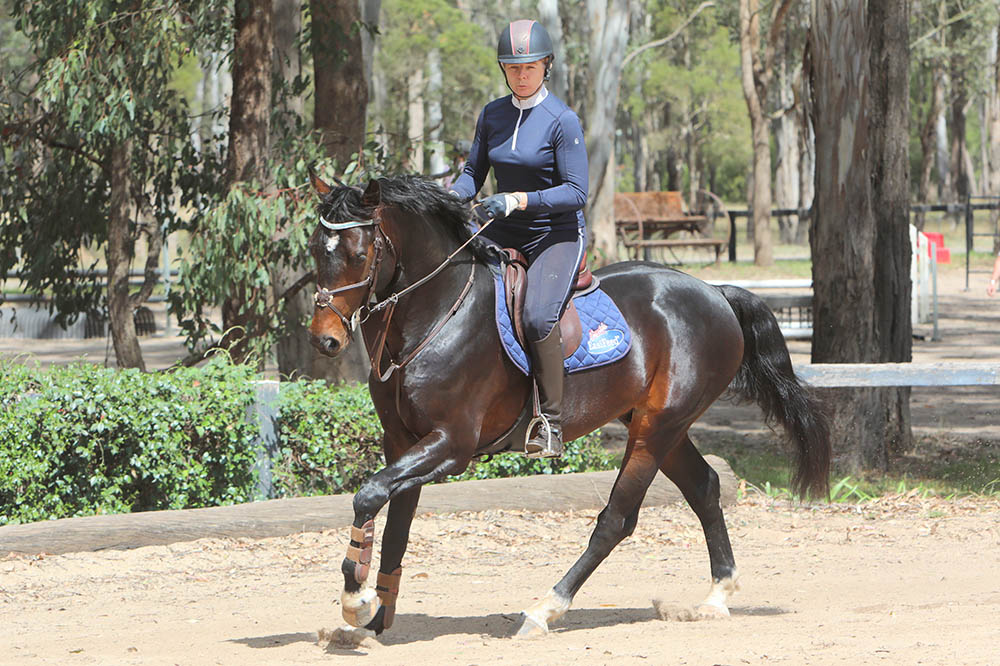
Helen Chugg’s knowledge and experience cover the gamut of producing horses, from genetics to breeding and foaling, to rearing young stock, breaking in and training, all the way to international competition. Helen has seen so many Grand Prix showjumpers come to fruition from insemination through many years of work and training to winning at the highest level. With Amanda Madigan now in the saddle of the Diamond B progeny, we have learned about the first three years of her horses’ lives in the September issue of Equestrian Life magazine. We now go through the timeline of the second stint of work for these up-and-coming four-year-old showjumpers.
They have had their three odd months’ spell after breaking in before coming back in to work, and then another few months off. It’s now down to the serious part of training; Helen reiterates that every day’s work is important and lays down better foundations for the future. It’s important to take each day as it comes. There are no two horses that are the same or take the same scale of training, but there is a main line that they like to not deviate far from. Every horse is its own personality and they each need special attention, as their attitudes and ways of going are all individual. We see the end result, but the most important factors are time, patience, and above all, Helen says, “Don’t let your expectations get in the way of thoughtful training. Every horse is different and we get an idea of what to expect along the way with our horses as we know the parents and their traits in previous offspring that they have produced.
“All this being said, you cannot compare one to another,” Helen continues. “You can’t expect them to be at a milestone at four weeks and then at four months. You have to take what they give each day, and when they are brought back in to work it’s all about gaining confidence through systematic training and gaining self-reliance and building the blocks toward a jumping competition. They all take their own time and you cannot put pressure on them to all be at the same stage at the same age.”
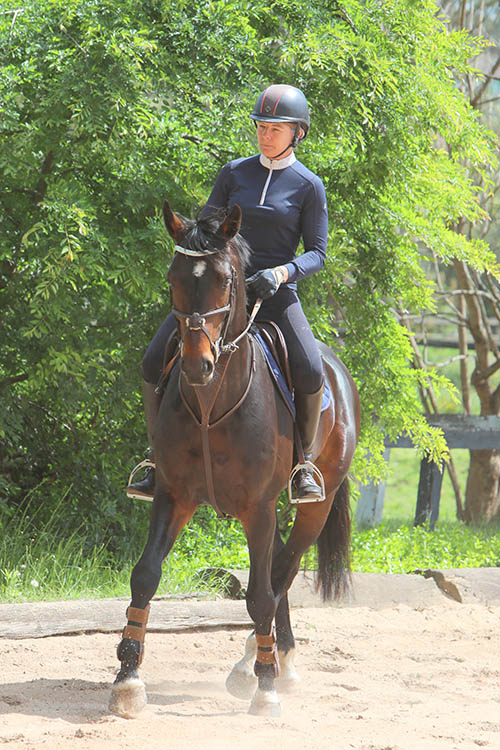
When they start work as almost four-year-olds, they begin on the lunge in the round yard for a few days. They also go on the walker so as to get into the routine of their working days at Diamond B. This work also takes the edge off them as far as being fresh and exuberant teenagers. Some need more time to realise they are back in work and others settle straight back in. Once they are settled then the riding with Amanda starts after a lunge. They are ridden in the round yard where the environment is familiar territory and conducive to concentration and reinforces their sense of routine. From a settled feeing in the round yard it is then off up the path to the dressage arena where the simple training that was started last time in continues — very basic transitions and feelings of controlling lines.
THE WORK CONTINUES
The horses now move into individual yards and stables. The herd is broken up, so to speak, as they now need individual surroundings to be removed from the pecking order and have a better chance of developing a bigger personality and less risk of injury. The horses are often changed around so as they do not learn to be attached and accept differing environments and outlooks. If they have a few days off and are types that can be excitable, they are put on the walker with which they are already familiar, and tacked up to simply loosen up and get their minds back to working.
So the routine continues but with more work and fitness. The lungeing is minimal and often it’s time to get straight on unless they show a degree of tension. There are some who are lunged before riding as it is better not to confront attitude but to try and deal with it in a logical and calm way as each horse develops a regimen that is specific to it yet always with the same basic principles.
The dressage training — flatwork — is as it was at the beginning, but with the transitions being made with more purpose and with quicker, more confident reactions. Every chance is made to get the horses in self-balance. Also, all exercise in the lateral work is with the intention of working to improve the straightness. It’s now time to introduce shoulder-in and travers and the work on walk to canter and canter to walk. Counter-canter is familiarised, and with some — depending on the canter and the attitude and the balance — flying changes.
The flatwork is continued around the jumps in the jumping arena. Attention to lines and transitions and being on the bit within the pace, and from one pace to another, are of the utmost importance. Poles to trot and canter over are an extension of what was learnt in the previous work and they simply become a complacent part of the daily work. There is no hurry to start jumping. The important thing here is a quiet attitude, balanced canter and acceptance of the even contact over poles, then over cavalettis.
All this straightness work and balance and confidence is over rails on the ground and cavalettis. The ground poles are at related distances and usually on straight lines. It’s simply a part of the daily routine and another day at the office with attention to a consistent rhythm and balance and allowing a steadying canter or a slightly more forward feeling, depending on the distance at the first pole. There is no use starting to jump fences if this can’t be achieved over poles. Helen and Amanda, at this stage, always keep the related lines easy and always on good rideable distances as they don’t want any surprises. The object is for the horse to think about his technique in the jump and good distances help with this.
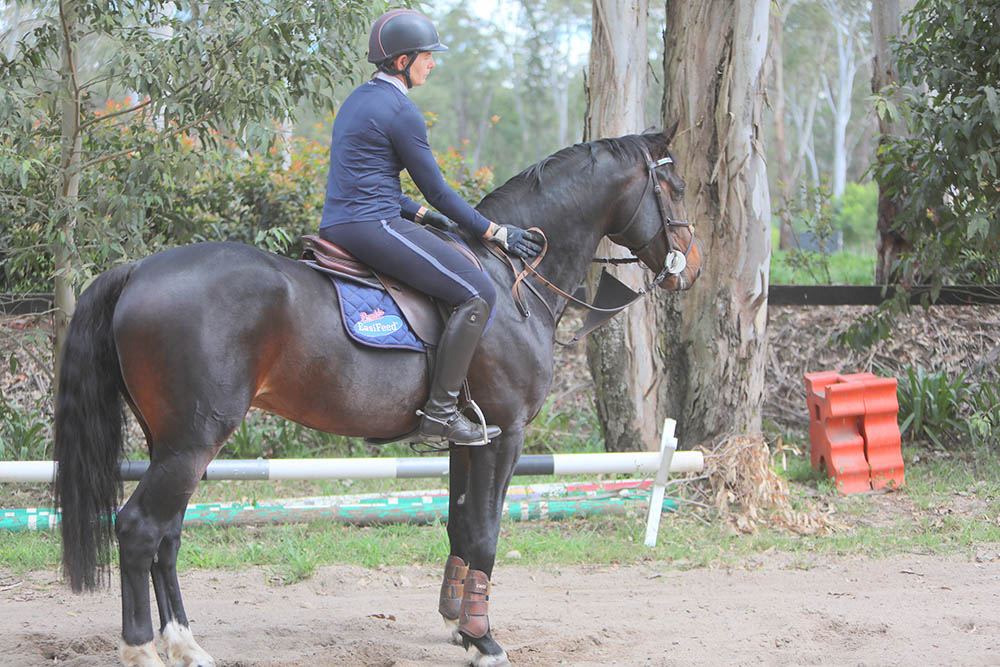
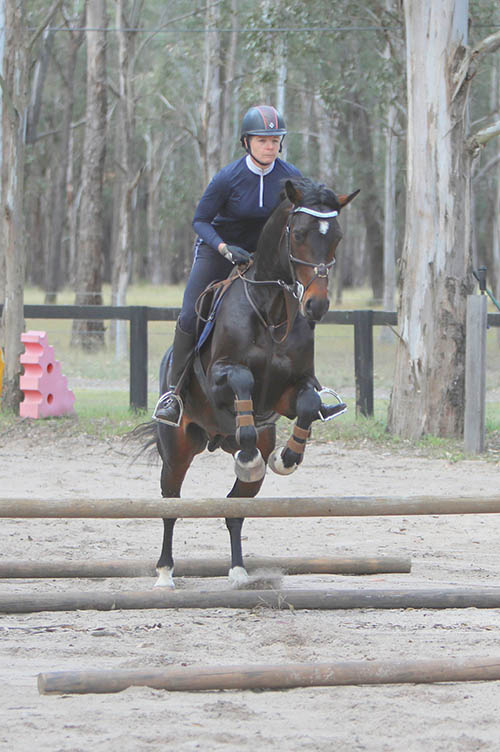
FEEL THE ATTITUDE
If you have a horse that runs at the cavaletti, you need to stop this. Make it from trot perhaps, and then on landing make a smooth transition to halt… and a pat… to encourage a relaxed and whoa-ing feeling. The lazy ones, on the other hand, need to land and get going! There is no knowing until you feel the attitude coming to the fence and on departure. The object is a good, consistent rhythm, tempo, straightness and balance, which are always the main positive focus.
Poles become a part of daily life, and whether a young horse or a Grand Prix one, they learn to train themselves to eye up distances and gain self-confidence whilst still allowing a good contact and willingness to the adjustability. They like to set related distances between simple fences. Having eyes on the ground is of the utmost importance. And to reiterate the feeling that Amanda has over the fences, a lot of video is used so she can see if what she is feeling is in keeping with the way each horse needs to be ridden.
STARTING TO JUMP
It’s time to start the jumping with fences of around 60-80cm built with not a lot of fill. There are both verticals and oxers, and the lines are simple strides usually between four and six, depending on the horse. Of course, at any time during any jumping efforts, if the horse reverts to what was being corrected as in a bid or a backward thought, then these idiosyncrasies are dealt with immediately. Initially it is a simple track of three to four jumping efforts, a break and then the same track again. It’s kept simple and easy, depending on the horse and how it handles the exercises.
Helen and Amanda don’t like to see their horses over-jumping, but if they do then the jumps are always low and very bland. This makes sure the horses don’t scare themselves as sometimes that is what over-jumping creates, especially over oxers where they may have the back rail down. By the same token, it’s also time to add interesting fill in to the fences; again they show them the fences and the new fills so that they are not surprised, and then with all the work on straightness and forward, there is no option but to confidently jump.
It’s amazing that a slack day and your horse gets a fright at a plank or a water tray and that sometimes can be a problem that takes a lot to correct. If it’s a bad weather day and windy and so on, it’s not a jumping day — it’s simply not worth it as a fright lasts a long time and has been the ruination of many a great horse.
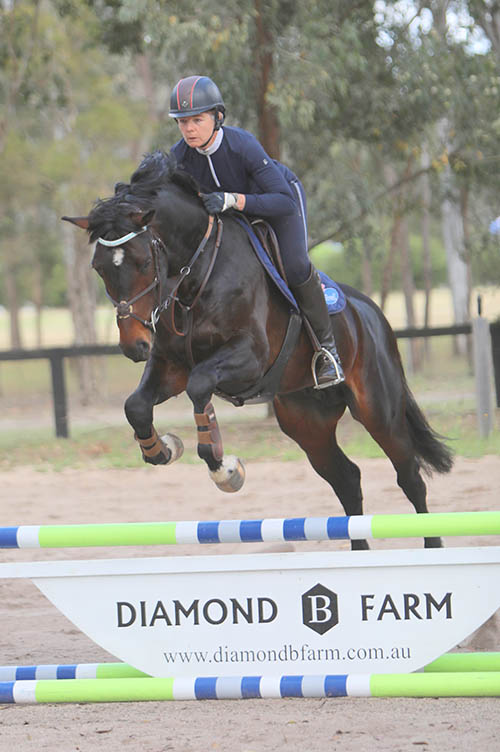
REFINE THE AIDS
It is now that Amanda has a feel for the bit and noseband combination that is needed to give a good even sensitivity in the reins. This cannot be written down as it is really a feeling and comes from experience; each horse’s contact is different and so needs attention towards bitting. Needless to say, a running martingale is often used to gain a more stable contact. And one with the V of the martingale filled in with leather as it’s otherwise easy for a young horse to grab the device in its mouth with dire consequences. Always better safe than sorry!
Saddle fit is also of the utmost importance as you don’t want any ill-fitting saddle that may create pressure areas at the jump. There are stud guards to be thought of and martingales and spur sizes and type.
It’s important that the bit suits the horse’s character and issues; sometimes with a horse that is strong in the hand, if you put more bit then it can interfere with the jump as they become offended. It’s a lot about trial and error, but Amanda knows the feeling that she wants in her hand and the amount of reaction to the leg, and so she is able to fit nosebands and bits and spurs to suit. It is a very important stage on a horse’s road to Grand Prix and it is essential to not be in a hurry, to let the fences come to the horses and to not protect them off the rails but for them to learn their own technique. The odd rail down is never chastised, it’s simply a learning experience for each horse and often it’s ‘hang on at the next fence’ as probably an over-jump may happen!
Some horses need a lot of jumping and even grid work. Some horses love to jump, and with these it’s important to really focus on the simple exercises and know that the jump will only be enhanced by the training.

TIME TO COMPETE… WHEN THEY’RE READY
“All horses are their own personality. They all are individual and we treat them as such,” says Amanda. “As much as we have a great system and follow this, we never expect horses to be ready to jump in this height class at four then this height at five. They all take their own time and we never hurry them just because there is a young horse competition in a few months and they should be doing certain expected things at that age. We listen to them and they really let us know when they are ready, and we take it as it comes along. As I said, they are all individuals and some learn quickly then plateau and then vice versa.
“We like to take them to a competition — and again it’s not about jumping bigger heights, it’s simply about confidence building and it’s always exciting to take the babies to a competition and see their differing reactions. Of course, these attitudes again we consider at home in their day-to-day training and feeding etc. Training the babies is always totally interesting and I do often feel traits in their jump and way of going that reminds me of the feel I had when I rode many of their parents. It’s a long and patient road to the top, and of course not all of our bred horses make it to Grand Prix, but we certainly treat each one with that outlook and intention. We start to realise their abilities and their strong points and we see their potential and who they would suit. Being totally realistic here we need to sell some so we can keep bringing on the younger ones. You always have to be realistic as much as it’s good to dream a little. And you never know, as some really do surprise you as they come in all sizes and shapes and it’s not till later that they really show you what they are made of.” EQ
YOU MIGHT ALSO LIKE TO READ:
PART 1 – ‘How Diamond B Produces Its Gems’ (Equestrian Life, September, 2021)
‘How Diamond B Became So Polished’ (Equestrian Life, November, 2020)









